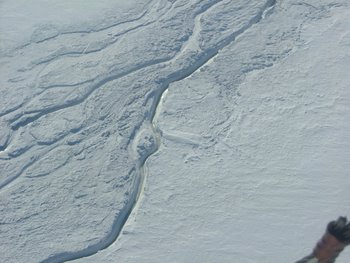Even with all of our weather delays, we were able to get our reconnaissance flight to the Shackleton Glacier in last Wednesday, January 12th. Once again, the weather placed the possibility of the flight in jeopardy. We were originally scheduled to fly out at 10 a.m. However, the weather was overcast with very low clouds, so the flight was postponed until the weather cleared. Around 2 p.m. we received the go ahead.
We flew out to the glacier on a Twin Otter. These planes are the secondary type of support aircraft based at CTAM. Our two pilots were Canadian and fly research teams in the Arctic every summer when they're not in Antarctica.
 The Twin Otter on the Shackleton Glacier. The two pilots are passing the time reading while waiting for us; you can see one lying on the left wing and the other sitting on the ski on the lower right.
The Twin Otter on the Shackleton Glacier. The two pilots are passing the time reading while waiting for us; you can see one lying on the left wing and the other sitting on the ski on the lower right.
Once again, it was an amazing flight over to the Shackleton. We flew close to the mountains which allowed us to see down into the bergshrunds and seracs where the ice from the polar plateau falls down into the valleys of the Transantarctic Mountains. It was about an hour long flight over to our destination. Once we reached the Shackleton, we circled Mt. Heacon a few times and then headed down glacier to Gemini Nunataks (a nunatak is a bit of bare rock sticking out of the ice). The Twin Otter had to make a couple of touch downs before the pilot could find a suitable landing site. The glacial ice was very rotten because it’s been so warm and is late in the season - much of the ice was covered with small melt ponds and in many places was just like Swiss cheese with all the small holes. We stayed on the glacier for about two hours while John and Perry literally ran down to the nunataks and spent about an hour and a half collecting samples for dating. Maurice and I wandered around the glacier, looking at the scenery and occasionally falling into the small holes (they were only about 12-18 inches deep).
 View of the Gemini Nunataks on the Shackleton Glacier. We're circling them in the plane, looking for a landing site.
View of the Gemini Nunataks on the Shackleton Glacier. We're circling them in the plane, looking for a landing site.
After John and Perry returned to the plane, we continued flying down glacier (northwards). We flew close to the east side and then made a huge arcing turn over the Ross Ice Shelf and flew back up the glacier along the mountains on the western side. Next year, John's team will return to continue their exposure dating project on the Shackleton Glacier. The reconnaissance flight was to look for acceptable sites for sample collection and to assess potential camping sites.
 Rivers of melt water on the Shackleton Glacier. Features such as this made finding a landing site tricky. We're probably 500 feet above the glacier at this point, so the streams are larger than they appear in the photo.
Rivers of melt water on the Shackleton Glacier. Features such as this made finding a landing site tricky. We're probably 500 feet above the glacier at this point, so the streams are larger than they appear in the photo.
We were gone for about four hours total, and it was, once again, another amazing gift to see the Transantarctic Mountain range up close. I've never flown so close to such majestic mountains; what a treat!
 View of the Shackleton Glacier in the Transantarctic Mountains as see from the Twin Otter. You can see the lateral moraine on the left and flow lines down the center.
View of the Shackleton Glacier in the Transantarctic Mountains as see from the Twin Otter. You can see the lateral moraine on the left and flow lines down the center.
